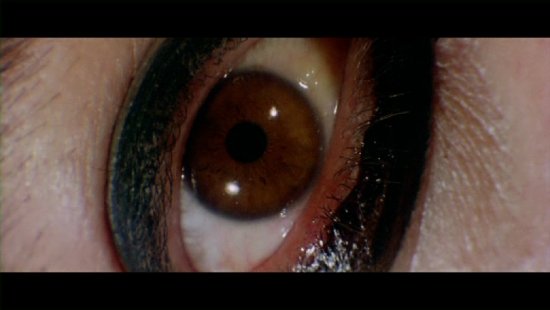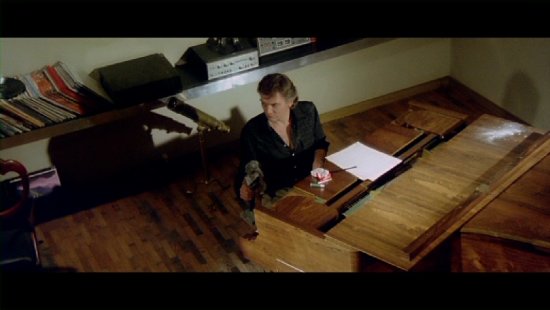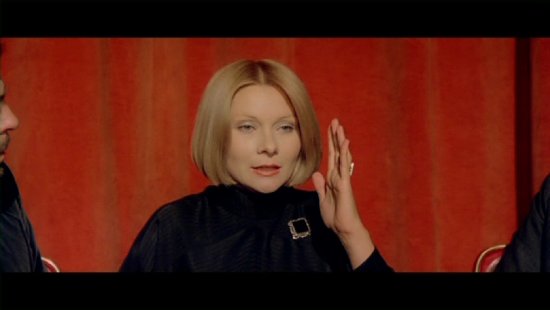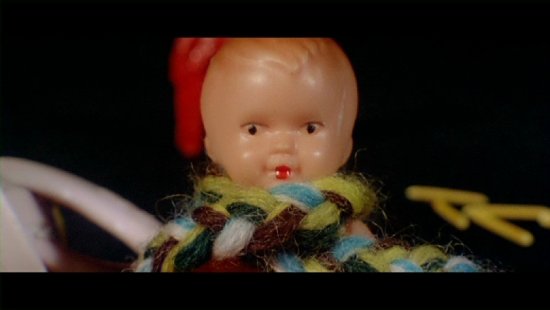Review for Deep Red (UK)(DVD)
Deep Red (Profondo Rosso)
1975; Dir: Dario Argento
Aka: The Hatchet Murders
Film
Perceived as both hero and villain in equal measure, the distinctive auteur known as Dario Argento has provide us with many a memorable moment throughout his 40 plus years as a filmmaker. Argento is fondly heralded as a master craftsman, in no small part due to his output in the Deep Red era, and up until the mid-Eighties. Whether it be through elusive tracking shots in Tenebrae (1982), the barmy razzle-dazzle lighting techniques innovated in Suspiria (1977), or in the genre-defining Giallo… Deep Red (1979). On the other hand, Dario has also become increasingly subject to strong criticism in the period since. Phenomena (1985) has it's admirers, but the plot involving Jenifer Connolly telepathically communicating with animals attracts a good degree of ridicule. Others regard Opera (1987) as his last genuine achievement, and bemoan the convoluted likes of US debut, Trauma (1993). The atrocious Phantom of the Opera (1998) and The Card Player (2004) perhaps represent the director at his most banal, whilst the mainstream has been given ammunition with which to label him almost amateurish. By his own standards, it's unfortunately not much of a stretch. The latter-day Argento also settled into a pattern of utilising commercial Rock songs on his soundtracks, a habit that seemingly offends traditionalists, though often unfairly so.
Thus, a new Dario Argento picture is greeted with trepidation, concern, and inevitably, disappointment. Simultaneously though, thanks to the advent of Blu-Ray technology, re-releases of his older material are among the most mouth-watering in the horror cannon. It would be unwise to dismiss or underplay the importance of his most accomplished work due to his recent failings. Deep Red (Profondo Rosso) could not be more typical of such enormously anticipated fare.
The film's plot is at first glance, typical Giallo. A Psychic woman is delivering a public seminar on the subject of telekinesis, but appears to see something horrible occur- a murder. Later piano teacher Marcus Daley (played by David Hemmings) , stumbles upon the same woman being stabbed to death at the window of her apartment, as he returns home. He attempts to save her, but fails. Although the police are contacted, Daley pursues the case independently, becoming obsessed with finding the murderer. He's aided in his quest by feisty reporter Gianna (Daria Nicolodi), but troubled by the feeling that he missed a clue- in a portrait painting he recalls from the Psychic's home that was gone the next day. As the investigation unravels and clues (and the obligatory red herrings) emerge, those involved are dispatched by the killer, in bloody fashion.
Obviously, the plot is of the traditional giallo variety, but Argento's effort represents the genre at it's peak. Pre-empting the Fulci gothic horrors half a decade later, Argento's excursions into murder here are extraordinarily violent. They're timed superbly, and paced deliberately, in a Fulci-esque manner that extracts maximum horror. This isn't the modern, snappy and disorientating violence of the Saw franchise, nor the hyper realism of recent French atrocities. Instead they're disorientating and disturbingly prolonged. On a couple of occasions, it's blatantly obvious when a character is about to face their demise, but the scenarios are frightening because they're absurdly over the top and almost trashy. Although dated (the blood is bright, bold, and anything but deep), the explosions of violence are so masterfully constructed that the aesthetics of the make-up hardly matter. A character is ludicrously scalded in a bathtub of running water, while the opening murder is a sensible precursor to the gruesome gambit that begins Suspiria. Of course, Argento frames everything beautifully, and perhaps more than any of his other films, exhibits a fabulous attention to detail here. Scenes are embellished with beautiful décor, with an almost painterly quality.
The real jewel in Deep Red's crown however, is the astonishing use of locations. Occupying a unique space between Armando D'Ossorio's otherworldly Blind Dead films, and distinctly modern trappings (well for it's time at least) of Bava's Blood and Black Lace (1964), Argento's film combines the kitsch with the elegant. Everything looks distinctly Italian, but feels as if one has stumbled into a modernist art exhibition hidden amongst the statuesque monuments and fountains. Hence, the architecture of the buildings stands out, be it clean, sleek, and distinctly bourgeois, or the crumbling beauty of an old house Marcus visits in a crucial plot development.
It would be remiss to mention the tremendous score too, one which marked Argento's first collaboration with Goblin, and him really finding his feet. A childish, haunting melody occupies the sound waves as the killer stalks their prey, and remains in the mind long after viewing.
Less memorable, but equally noteworthy are the moments of comedy scattered throughout. Mainly revolving around Nicolodi and Hemmings, they slow the pace for some viewers, but for this writer, added a stark and valuable contrast to the hyper-cruel story at the heart of the piece. They're also genuinely humorous- a facet that isn't often the case with genre cinema, which usually suffers from poorly defined characters. Here, they're richly defined, and the odd light moment elevates their empathy, even if several fail miserably (the scenes involving the police are excruciating- thanks to familiar flaws… abysmal dialogue for supporting characters, and alien dubbing).
Shorn of 11 seconds of material in it's original UK certified release, this version restores previous cuts, and offers fans the opportunity to experience the film in both the uncut Italian version, or in the snappier, theatrical version. Both are tremendous, and the film stands alone either way, but the longer cut rewards repeat viewings. Hardcore horror fans may find the shorter version has more impact, regardless, Deep Red in either incarnation is simply a work of art.
Audio and Visual
Fortunately, the 2.35:1 Anamorphic image is absolutely stunning, especially given the age of the material, and the nature of it's various releases. It's something of a miracle that it manages to retain such crisp, vibrant colour.
The cracking Dolby Digital 5.1 track also delivers the goods.. A vital component given just how important the soundtrack is. The soundtrack is piercing without being overbearing, while the only real issue, is the sometimes out-of-synch dubbing. That's nothing that can be solved though, as the English dialogue
Obviously, those who have already made the upgrade to Blu-Ray should plump for the superior format. However, those still wading through DVD's should rest assured, everything looks and sounds great here.
Extras
As is now the norm, Arrow have assembled an impressive line-up for a much anticipated release. Just as well, because for a film like Deep Red, anything less is unacceptable in 2010. There could be more of course.. As the various interviews and segments are rather short pieces. It's understandable though, as they've obviously been filmed at the same time as those of the other Argento releases, and there's obviously they haven't had an enormous amount of time to afford each film individually. Frankly , given the wealth of material out there, and on previous releases of the Director's work, it's nice to see features that are new and fresh, regardless of their length.
The Lady In Red is a fascinating interview with Daria Nicolodi, meanwhile, Music to Murder for ! gives us a different perspective, from long-term Argento collaborator, Claudio Simonetti.
Rosso Recollections Dario's Deep Genius sees Argento discusses his career in immodest Italian fashion, recollecting his experiences and concerns at the time. He also debunks the notion of a 3D remake that has been doing the rounds the past couple of years. As is normal with the genre however, anything said has to be taken with a hefty pinch of salt. Job well done by Calum Waddell and the crew.
Also interesting, are the twosome of trailers offered. The Italian one is vague, yet cleverly compelling, while the US variant completely ruins the film, spoiling death scenes, and removing possible suspects from the equation. Typical exploitation cinema there!
Best of the bunch award must surely go to a feature on the Profondo Rosso shop in Rome. Taking in an interview and tour with owner Luigi Cozzi, this is an insightful, nostalgic gem. The shop also has a museum of memorabilia and props from the Argento umbrella of films.
Rounding the set off, Critic/Expert Thomas Rostock contributes a commentary track that is certainly worth a listen. I'm of the personal disposition that tracks always work better with either the cast or filmmakers involved- ideally, a combination of both. Often, an expert's opinion can come across as dry and dull. To his credit, Rostock is very informative, though it does come across as if he's reading a thesis over the top of the film. Someone to bounce off would have helped greatly here.
Conclusion
One would be hard pressed to find a more definitive DVD release of Deep Red, one of Argento's most significant cinematic entries.
It's appropriate too, because arguably, no effort in his repertoire more succinctly, and perfectly, sums up Argento and his obsessions. Family history, and repressed problems are at the heart of this piece, which on the surface, appears to be concerned entirely with glamorous tracking shots, and sinister, roving cameras picking up the most minor, yet significant of details. Certainly though, the tendency to sway towards such trickery and shenanigans is what makes Deep Red such a bravura, electrifying experience.
In short, with Deep Red, Argento provides a transition between his previous efforts, and the supernatural terrors to come in his future work. Deep Red is the uppity snob of the violent, exploitative, Seventies horror scene. It's the one that stands out as believing it's better than the rest. Arguably it is.




Your Opinions and Comments
Be the first to post a comment!